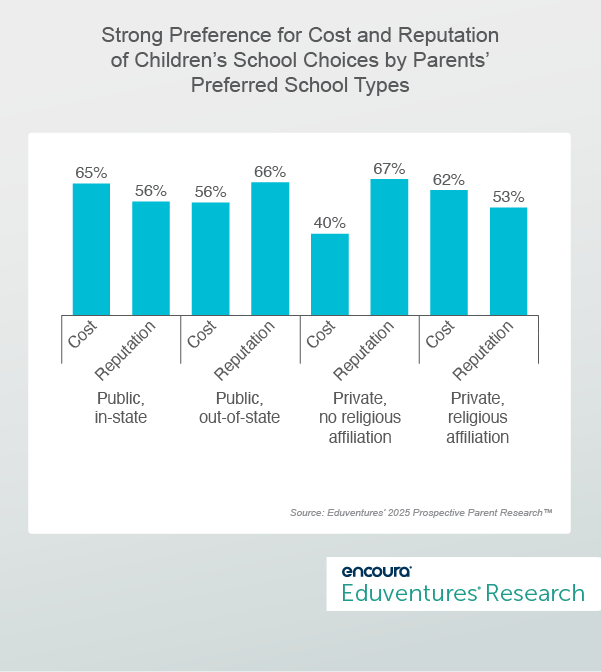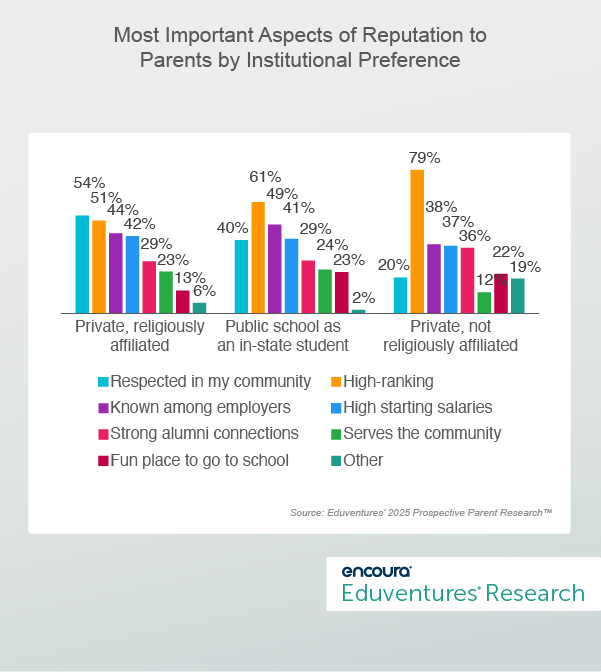Things appear to be looking up for religious institutions. After years of enrollment decline, recent news stories cite enrollment growth and growing parent interest in faith-based education. Indeed, small schools like Belmont Abbey College and Asbury University enrolled record incoming classes this past fall. Both institutions attribute this success to doubling down on faith-based values and missions.
But success stories like these mask the fact that total enrollment in the sector declined by 3% between 2013 and 2023 while secular private enrollment grew by 13%. This aligns with overall market trends moving away from educational experiences that are explicitly religious.
Why do some institutions attract families seeking faith-based education while others do not? Perhaps the key lies in understanding how these families evaluate them.
Small Fish in Big Ponds
According to the recent news stories, a growing number of parents are finding a new appetite for faith-based institutions that provide a safe haven for their students—far from campus protests and other turmoil they fear students may encounter at secular institutions.
While this is welcome news for struggling faith-based schools, they must keep in mind that this growing interest still represents a small number of families. The Eduventures Prospective Parent Research™ and Prospective Student Brand Research™ reveal that few families specifically seek religiously affiliated institutions: 18% of students and 6% of parents say they are interested in faith-based schools (among other options).
Overall, however, in-state public institutions remain the schools of choice: 53% of parents prefer them, as do 45% of students. The reason, of course, is the more desirable in-state tuition. Faith-based institutions, like all private schools, can’t compete on sticker price and must ground their appeal to students in academic rigor, career outcomes, but also financial aid.
What faith-based institutions may not realize, however, is that they must make a stronger case on net cost than their secular peer institutions. Figure 1 shows the proportion of parents with a strong preference for their children’s school choices based on cost and reputation, broken out by their preference for institutional type.

Figure 1
Here we can see that parents who would like their children to attend an out-of-state public institution value a school’s reputation more than its cost, just like parents who prefer private, secular schools. This makes sense, since out-of-state tuition is similar to private institution sticker prices, and financial aid is not as generous as for in-state students.
Interestingly, though, parents who prefer private, religious institutions value cost over reputation. This makes them very different from their secular private peers and quite similar to the parents who would prefer an in-state public institution.
The reason, perhaps, is that the parents who are looking at religiously affiliated institutions are also in the market for their local state schools. The vast majority of parents who prefer public or secular private institutions are overwhelmingly confident their children will attend these types of schools. Less than half of parents who prefer a faith-based school, however, are confident their children will attend one.
For instance, 89% of parents who prefer an in-state public institution believe their children will attend one. But only 47% of private religious proponents think their children will attend a private institution (regardless of affiliation), and 44% believe their children will attend an in-state, public institution. This suggests that religiously affiliated institutions primarily compete with each other and with the local state schools.
But even though cost is a stronger consideration for these parent prospects, more than half still have a strong preference based on reputation. Do these parents evaluate reputation similarly to those who favor an in-state institution for their children, or do they use the same criteria as parents who prefer a private, secular institution? The former seems closer to the truth, according to Figure 2, that shows which aspects matter most to parents as they evaluate a prospective college’s reputation.

Figure 2
In the aggregate, Figure 2 indicates that rankings are the most important factor to parents. But viewed through the lens of institutional preference, we see that rankings matter most to parents who prefer a private, secular institution, and least to those who prefer a religiously affiliated institution. Public institutions, whether in-state or out-of-state (not shown here), are somewhere in between.
What matters most to parents who prefer religiously affiliated institutions is whether the school is respected in the parent’s community—a factor that does not matter much for private, secular institutions and only somewhat for in-state, public institutions.
Further, parents who prefer religious institutions are thinking about future career outcomes, i.e., is the school known among employers and do graduates get high starting salaries? Again, this makes the evaluation process more like that of in-state, public institutions rather than secular privates. Yet, many religious institutions lead with values, not value, in the recruitment conversation.
Perhaps the religiously affiliated institutions experiencing recent enrollment growth have recognized these patterns and were able to capitalize on reputation with the families that are open to faith-based education. Perhaps other schools can follow in their footsteps. But remember that the overall number of families who seek faith-based institutions remains small, suggesting not all can count on this strategy.
The Bottom Line
Even with growing interest in safe, faith-based environments, competition remains stiff for religiously affiliated institutions. Not only are they competing with other faith-based schools, but also with local public institutions. Demographic declines, concerns about cost, and growing skepticism about the value of higher education further complicate future enrollment growth.
Many religiously affiliated institutions must not only appeal to the families that specifically seek this type of education, but also to families who prioritize affordability and return-on investment and may not be completely sold on faith-based education.
To remain relevant to their core market and beyond, religious institutions should:
- Lead with affordability and outcomes. Families may like the missions and values of faith-based institutions, but whether the education leads to desired outcomes is still very much top-of-mind. Additionally, cost is a concern. Financial aid availability should be increased whenever possible but providing proof of a solid return-on-investment is a must for faith-based institutions.
- Invest in the community. Community perceptions are key for families choosing faith-based schools, surpassing formal rankings. Building brand equity relies more on word-of-mouth than published rankings. To enhance reputation, schools should engage in ongoing community service and events, and strengthen relationships with local employers.

Eduventures Summit – higher education's premier thought leadership event – is just a few weeks away. Secure your spot today!

